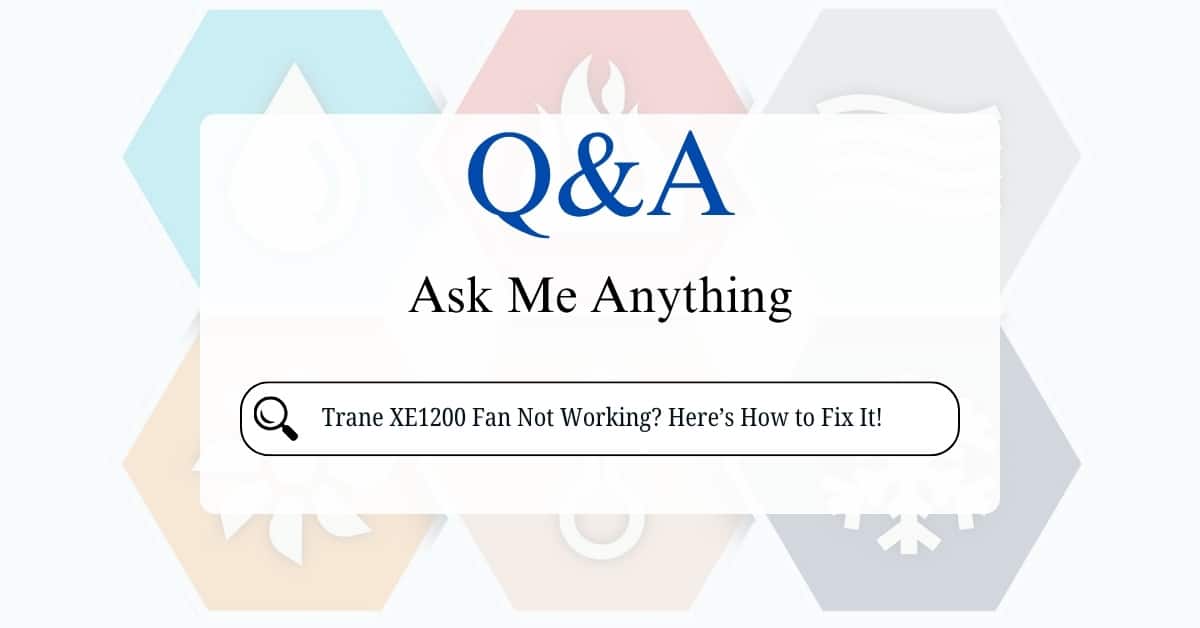If your Trane XE1200 fan isn’t working, don’t panic! A non-functioning fan can stem from several issues—some simple fixes you can do yourself, while others may require professional help. This guide will walk you through the most common causes and solutions in a friendly, step-by-step manner.
1. Check the Thermostat
Before diving into complex troubleshooting, always start with the thermostat—it’s often the easiest fix!
What to Do:
- Make sure the thermostat is set to “Cool” or “Fan On” mode.
- Lower the temperature setting to see if the fan kicks on.
- If your thermostat uses batteries, try replacing them (a dead battery can cause weird issues).
Pro Tip:
If you have a programmable thermostat, try resetting it to factory settings in case it’s stuck in a weird mode.
2. Verify Power Supply (No Power, No Fan!)
If the thermostat seems fine, the next step is checking power sources.
A. Check the Circuit Breaker
- Go to your home’s electrical panel and look for the breaker labeled “HVAC” or “Air Handler.”
- If it’s tripped (middle position), flip it OFF and then back ON to reset it.
B. Inspect the Disconnect Switch (Outdoor Unit)
- Your outdoor unit has a disconnect switch (usually a small box near the condenser).
- Open it and make sure the switch is in the ON position.
C. Check the Furnace/Air Handler Power Switch
- Some systems have a light switch-like toggle on or near the indoor unit.
- It might look like a regular wall switch—flip it to ON if it’s off.
3. Test the Capacitor
If the fan isn’t spinning but you hear a humming noise, the capacitor might be bad. Capacitors help start the fan motor, and they wear out over time.
Signs of a Bad Capacitor:
- Bulging or leaking (looks swollen or has oil residue)
- No fan movement (just a humming sound)
How to Test It (For DIYers):
- Turn off power at the breaker.
- Discharge the capacitor (short the terminals with an insulated screwdriver to avoid shocks).
- Use a multimeter set to capacitance mode to check if it matches the rating printed on the capacitor.
Replacement:
If it’s bad, buy an identical replacement (same µF rating and voltage). Capacitors are cheap and widely available at HVAC supply stores or online.
4. Check the Fan Motor (Is It Dead?)
If the capacitor is good but the fan still won’t spin, the motor itself could be the problem.
Signs of a Bad Fan Motor:
- Burning smell (overheated windings)
- No movement (even with a good capacitor)
- Loud grinding noises (bad bearings)
Testing the Motor:
- Disconnect power.
- Remove wires from the motor.
- Use a multimeter to check for continuity (no continuity = dead motor).
What to Do Next:
If the motor is dead, you’ll need a replacement. Look for the model number on the motor label and order an exact match.
5. Inspect the Contactor (Does It Engage?)
The contactor is a relay that sends power to the fan when the thermostat calls for cooling. Over time, the contacts can wear out or stick.
Signs of a Bad Contactor:
- Charred or pitted contacts (blackened metal)
- No clicking sound when the thermostat calls for cooling
Testing the Contactor:
- Turn off power.
- Check for 24V across the coil (if no voltage, the thermostat or wiring is the issue).
- If voltage is present but the contacts don’t close, replace the contactor.
6. Check Wiring & Connections (Loose or Burnt Wires?)
Electrical connections can loosen or corrode over time, causing fan failure.
What to Look For:
- Burnt or melted wires (especially near the capacitor or motor)
- Loose terminals (wiggle wires to see if they’re secure)
Fixing Wiring Issues:
- Tighten loose connections.
- Replace damaged wires (use the same gauge wire).
7. Test the Fan Relay (Indoor Blower Issue)
If the indoor blower isn’t working (but the outdoor fan is), the issue might be the fan relay in the furnace or air handler.
How to Check:
- Set the thermostat to “Fan On.”
- Listen for a click (relay engaging).
- If no click, test for 24V at the relay terminals.
Solution:
- If the relay is bad, replace it (they’re inexpensive).
8. Check Safety Switches
Your HVAC system has safety switches that shut off the fan if something’s wrong.
Common Safety Switches:
- High-limit switch (trips if the furnace overheats)
- Pressure switch (in some systems, detects airflow issues)
How to Test:
- Use a multimeter to check for continuity across the switch.
- If open (no continuity), the switch may need replacement or resetting.
When to Call a Professional
If you’ve tried these steps and the fan still won’t work, it’s time to call an HVAC technician. Some issues (like refrigerant problems or complex electrical faults) require professional tools and expertise.
A non-working fan on your Trane XE1200 can be frustrating, but many fixes are DIY-friendly. Start with the thermostat and power supply, then move on to the capacitor, motor, and wiring. If all else fails, don’t hesitate to call a pro!
Did this guide help? Let me know what you find—I’m happy to help further!






